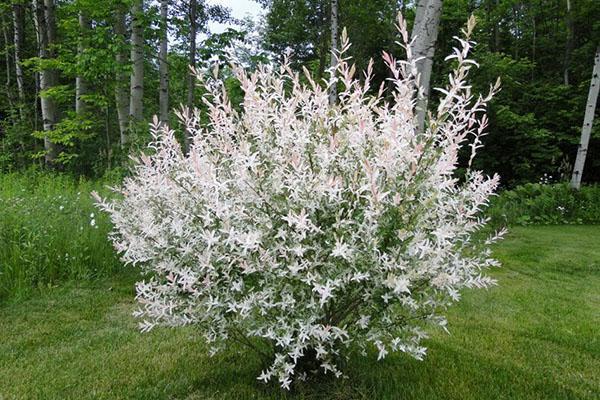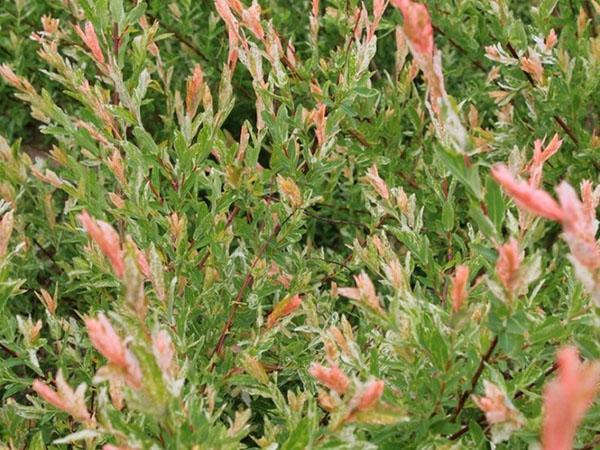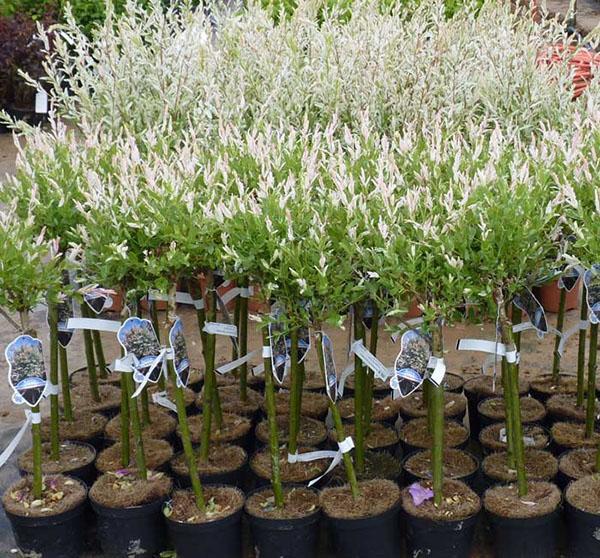Japanese willow Hakuro Nishiki - description, planting and care rules
 Iwa Hakuro Nishiki is radically different from the usual wild-growing weeping relative, but belongs to the same family. It is a short, perennial shrub with upward branches. Many designers prefer this variety because of its relative simplicity and the ability to form an unusual crown on the tree. In addition, the willow leaves of Hakuro Nishiki are colored not only green, but also in other colors and shades.
Iwa Hakuro Nishiki is radically different from the usual wild-growing weeping relative, but belongs to the same family. It is a short, perennial shrub with upward branches. Many designers prefer this variety because of its relative simplicity and the ability to form an unusual crown on the tree. In addition, the willow leaves of Hakuro Nishiki are colored not only green, but also in other colors and shades.
Hakuro Nishiki is native to Japan, but can grow in temperate climates.
Description and features of the variety

The bark of Hakuro Nishiki's whole-leaved willow is colored gray-green, and over time it turns gray. Shoots are brown with a red tint. The leaves are oblong in shape, painted in a pale pink color. Over time, they acquire a light green hue, turn yellow and fall off in the fall.
Planting and care rules
 Even a novice gardener can handle planting and caring for Hakuro Nishiki's willow. This is a rather unpretentious variety that can be transplanted at a mature age. The main thing is to choose the right place for planting young bushes, and they will feel good and grow quickly. In addition, it is necessary to prune Hakuro Nishiki's willow in order to form the correct round crown.
Even a novice gardener can handle planting and caring for Hakuro Nishiki's willow. This is a rather unpretentious variety that can be transplanted at a mature age. The main thing is to choose the right place for planting young bushes, and they will feel good and grow quickly. In addition, it is necessary to prune Hakuro Nishiki's willow in order to form the correct round crown.
For growing at home, you can buy ready-made bushes.
Preparation of seedlings and planting them in open ground
 Willow is native to Japan, but it has adapted well to a temperate climate with temperature fluctuations in winter and summer. Like other willow varieties, this variety prefers moist soil. The optimal place for planting seedlings is the banks of natural or artificial reservoirs. Otherwise, it is necessary to constantly monitor the level of soil moisture and prevent the bushes from drying out.
Willow is native to Japan, but it has adapted well to a temperate climate with temperature fluctuations in winter and summer. Like other willow varieties, this variety prefers moist soil. The optimal place for planting seedlings is the banks of natural or artificial reservoirs. Otherwise, it is necessary to constantly monitor the level of soil moisture and prevent the bushes from drying out.
Hakuro Nishiki's willow propagation occurs in two ways:
- cuttings - they are harvested in early spring, after which they can immediately be planted in open ground;
- grafting on other trees is the main technology for creating Hakuro Nishiki's willow on a trunk.
The main way to reproduce willow at home is by cuttings. Cuttings are branches that are taken from mature shrubs in early spring. The most important thing is to have time to get them before the beginning of the growing season, so as not to harm the mother plant. Cuttings do not need preliminary preparation: it is enough to lightly dry the cut site and lower it into the soil. During the warm period, the seedling will take root and begin to grow. The bushes begin to bloom approximately in the third year of life.
Some experts keep cuttings in hot water for several hours - this way they grow faster, and in the first year they can add up to 90 cm.
Planting and caring for Hakuro Nishiki's whole-leaf willow is possible at home. Another way to get unusual trees is by stamping. A stem is a tree with a strong, even trunk, on the top of which a Japanese willow is grafted. Most often, goat willow is used for this purpose, which has a tree-like straight trunk.
Tree care
 Planting and caring for Hakuro Nishiki's Japanese willow does not take long. It grows well without additional fertilization and daily watering, if you choose the right place for planting bushes. There are some rules that will help a willow grow tall and healthy:
Planting and caring for Hakuro Nishiki's Japanese willow does not take long. It grows well without additional fertilization and daily watering, if you choose the right place for planting bushes. There are some rules that will help a willow grow tall and healthy:
- the plant tolerates stagnant moisture better than drying out the soil, so it should be watered constantly;
- for planting, it is better to choose a place with a high level of groundwater;
- for feeding you can use organic fertilizers - compost or humus;
- for the prevention of fungal diseases, the leaves are sprayed with fungicidal agents:
- it is better to take seedlings from bushes in the region in which they are planned to be planted - this way they quickly adapt to climatic conditions.
 Willow variety Hakuro Nishiki, like other members of the willow family, prefer well-lit areas. It can also grow in partially darkened places, if bright sunlight falls on them during the day. It grows slowly in the dark, and its leaves seem weak. Willow is unpretentious to the type of soil. However, if you plant it on clay soil, sand or peat should be added to it for better moisture conductivity.
Willow variety Hakuro Nishiki, like other members of the willow family, prefer well-lit areas. It can also grow in partially darkened places, if bright sunlight falls on them during the day. It grows slowly in the dark, and its leaves seem weak. Willow is unpretentious to the type of soil. However, if you plant it on clay soil, sand or peat should be added to it for better moisture conductivity.
Japanese willow is resistant to temperature extremes and tolerates winter frosts. If the frost is strong, some shoots may freeze slightly, but this does not harm the entire bush. Such branches simply need to be cut during the first spring haircut.
Only standard trees are sensitive to frost, namely the place of grafting of Hakuro Nishiki to another variety. This site for the winter is wrapped with special materials - agrofibre or lutarsil.
Crown pruning
 Since this willow variety is a shrub with long, even branches, their growth can be adjusted. With proper and timely pruning, the plant looks thick and lush. This process also has its own characteristics:
Since this willow variety is a shrub with long, even branches, their growth can be adjusted. With proper and timely pruning, the plant looks thick and lush. This process also has its own characteristics:
- the first formative pruning is carried out in the spring, before the beginning of the growing season;
- do not be afraid to cut off excess shoots - the bush quickly regains its shape due to the growth of new ones;
- in the first year, no more than 4-6 buds are left, each year adding 1 bud to this length;
- at the end of autumn, the last haircut is carried out, for which dry or diseased branches are cut.
As a result of competent work with the shape of the crown, the willow becomes like a ball. If it grows on a trunk, the tree resembles a huge dandelion. It is also necessary to cut off excess shoots along the trunk of the standard tree.
Japanese willow in landscape design
 A photo of Hakuro Nishiki's willow in landscape design is a neat low plant with a rounded crown. These bushes are bred specifically for decorative purposes, they are planted in the courtyard of the house, as well as in parks and recreation areas. They can be planted either alone or in combination with other plants. Standard Japanese willows are in great demand.
A photo of Hakuro Nishiki's willow in landscape design is a neat low plant with a rounded crown. These bushes are bred specifically for decorative purposes, they are planted in the courtyard of the house, as well as in parks and recreation areas. They can be planted either alone or in combination with other plants. Standard Japanese willows are in great demand.
There are several decorative uses for Hakuro Nishiki:
- several bushes, planted in a row, form an unusual hedge;
- single bushes or standard trees are best planted against the background of green mass, so they will stand out favorably;
- willow looks good and grows quickly around small artificial ponds;
- it is often planted along with another member of the willow family - the Matsudan willow.
 Since this plant immediately catches the eye due to its unusual shade, it will look harmonious in any garden. In addition, even in winter, it will be distinguished by red shoots. The main rule is to choose well-refreshed areas as a landing site. Japanese willow will not grow healthy near tall trees with a wide crown, as they will block it from the sun's rays.
Since this plant immediately catches the eye due to its unusual shade, it will look harmonious in any garden. In addition, even in winter, it will be distinguished by red shoots. The main rule is to choose well-refreshed areas as a landing site. Japanese willow will not grow healthy near tall trees with a wide crown, as they will block it from the sun's rays.
 In the photo, Hakuro Nishiki's willow looks like a spherical bush of different shades of pink, green and gray.The main purpose of its breeding is landscape design, decoration of gardens, parks and recreation areas. She is quite unpretentious - despite the fact that her homeland is Japan, she is adapted to live in a temperate climate and tolerates frost well. It will grow especially quickly if the soil under it is constantly moist. Even a novice gardener can cope with the cultivation of this willow variety - it is very easy to care for it and form a crown.
In the photo, Hakuro Nishiki's willow looks like a spherical bush of different shades of pink, green and gray.The main purpose of its breeding is landscape design, decoration of gardens, parks and recreation areas. She is quite unpretentious - despite the fact that her homeland is Japan, she is adapted to live in a temperate climate and tolerates frost well. It will grow especially quickly if the soil under it is constantly moist. Even a novice gardener can cope with the cultivation of this willow variety - it is very easy to care for it and form a crown.